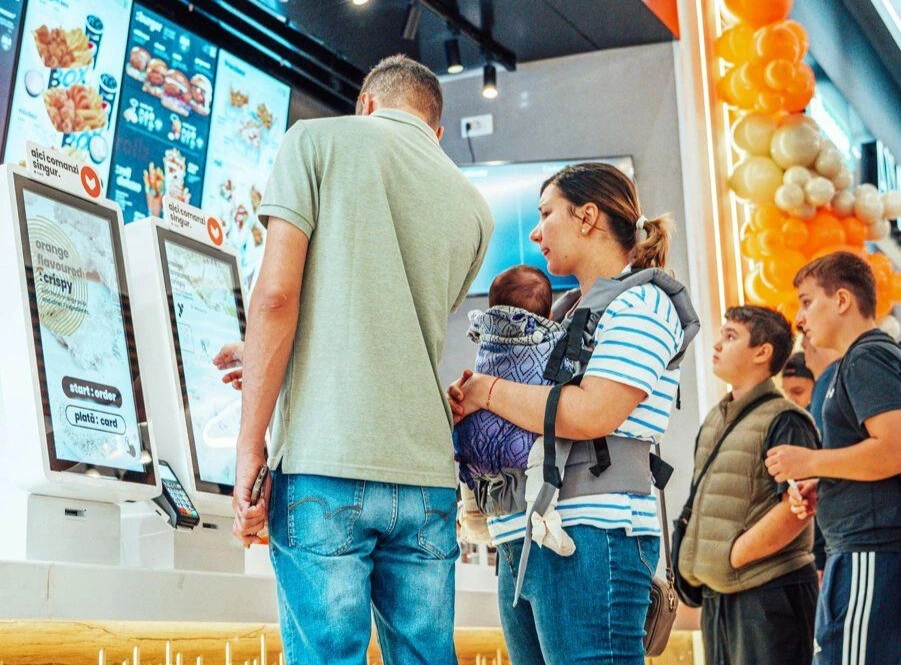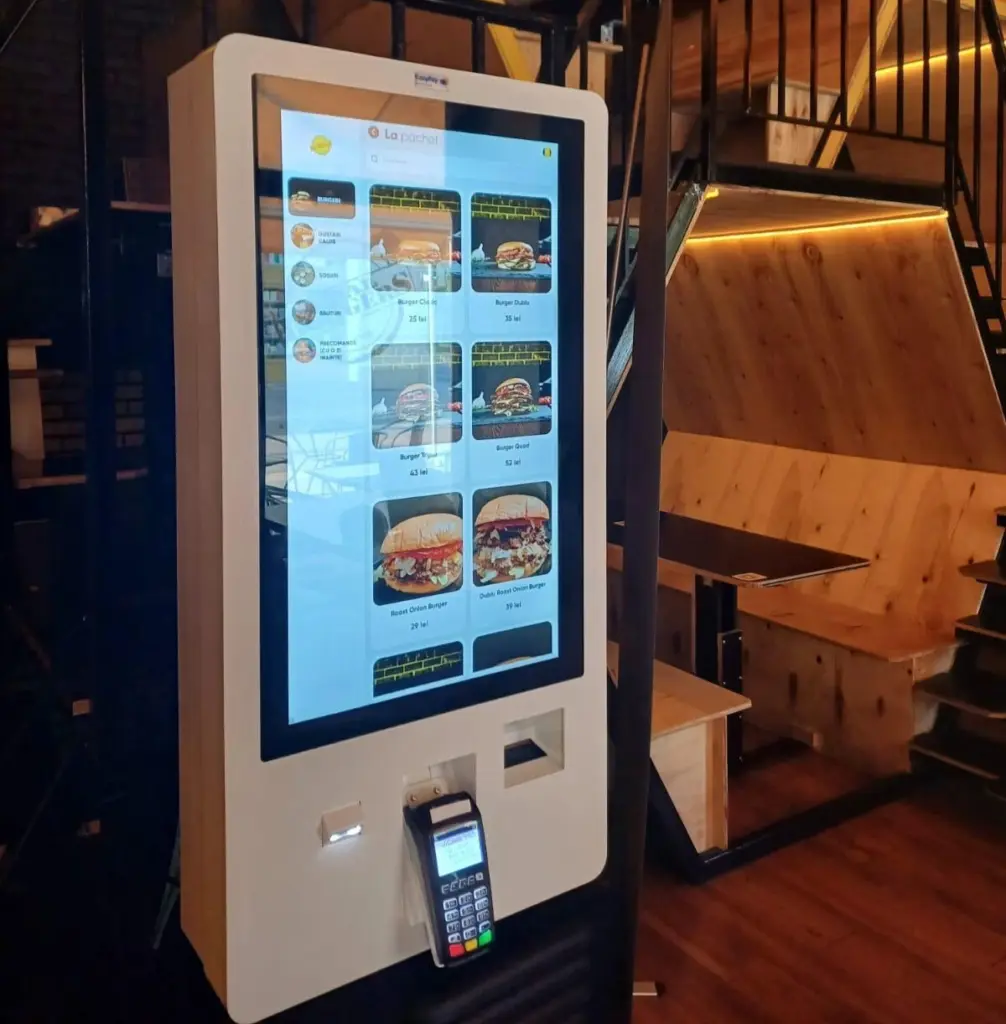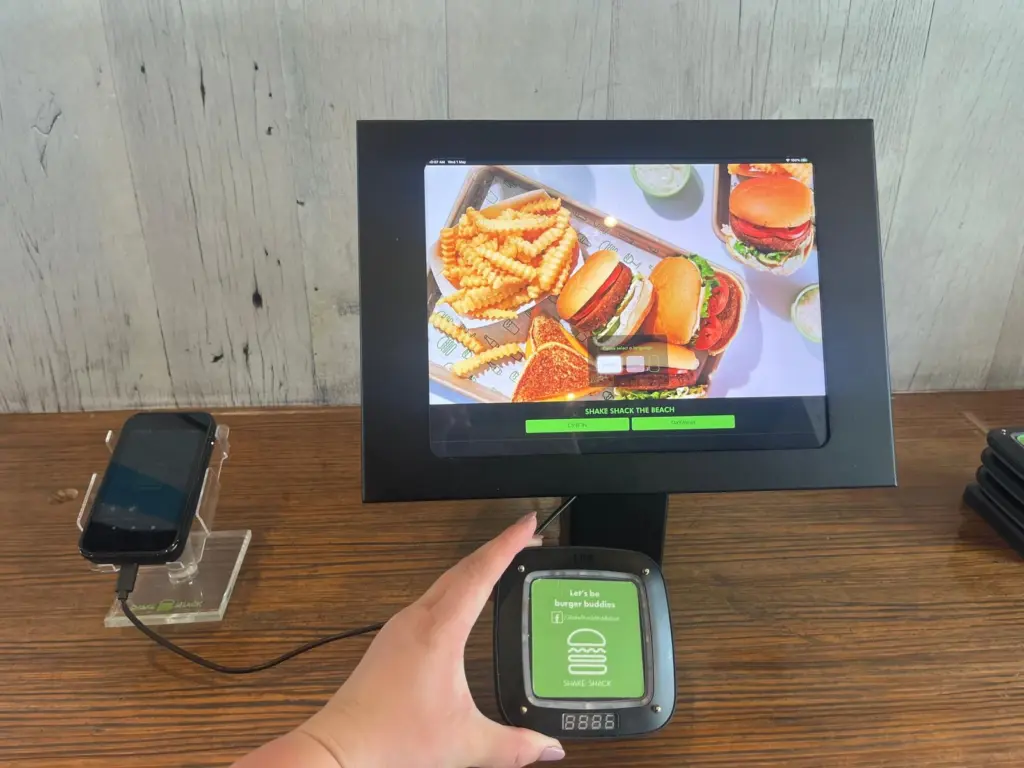All Articles
All You Need to Know About Restaurant Kiosk Cost

As self-service ordering becomes increasingly mainstream, restaurant kiosk cost has become a key consideration for eateries of all sizes. The pandemic accelerated the trend toward widespread adoption of restaurant kiosks as part of the industry’s digital transformation. Major fast-food chains like McDonald’s and Taco Bell led the way in introducing these kiosks, and the technology has since spread to fast-casual and quick-service restaurants worldwide. The appeal is clear: self-order kiosks can speed up service, improve order accuracy, and even boost sales through upselling, all while optimizing labor. For restaurant owners, kiosks offer a chance to enhance the guest experience and increase efficiency – but understanding the costs involved is crucial to making an informed investment.
In this guide, I will explain self-ordering kiosks, explore the different types available, break down the factors that influence restaurant kiosk cost, provide accurate pricing ranges for restaurant kiosks, and introduce TapTasty, a modern software solution for self-ordering kiosks. By the end, you’ll have a clear understanding of restaurant kiosk cost and how to evaluate the investment for your business.
What is a Self-Ordering Kiosk?
A self-ordering kiosk is a digital touch-screen terminal (either a tablet or a larger computer kiosk) that allows customers to place orders and make payments independently, without needing assistance from a cashier. In simple terms, it’s like a self-service POS system dedicated to customer ordering. The kiosk presents the restaurant’s full menu on-screen, enabling patrons to browse items, customize their selections, and then submit the order directly to the kitchen in real time. Payment is typically integrated, so customers can swipe or tap their card (or use mobile pay) to complete the transaction on the spot.
Types of Self-Ordering Kiosks
Restaurant self-ordering kiosks are available in various forms designed to meet different business needs, layouts, and budgets. Here are some of the most common types of self-ordering kiosks and their features:
Freestanding Kiosks
Freestanding kiosks are full-size, floor-standing terminals that typically feature large touch screens (ranging from 20 to 32 inches) mounted on a sturdy pedestal or stand. Commonly found in fast-food restaurant lobbies – such as the familiar “Order Here” stations at McDonald’s – these kiosks are highly visible and ideal for areas with heavy foot traffic. They usually come equipped with all essential hardware components, including:
- Touchscreen display
- Internal computer
- Card reader for payments
- Receipt printer
Due to their larger size and durable construction, freestanding kiosks generally have a higher cost compared to smaller kiosk models. However, they deliver a premium self-service experience and, when properly designed, comply fully with ADA accessibility standards.
Countertop Kiosks

Countertop kiosks are compact self-ordering terminals designed specifically for placement on counters or tables. Ideal for establishments with limited space, such as cafés, these kiosks allow customers to conveniently place orders—for instance, coffee or pastries—without taking up much room. Countertop kiosks typically feature:
- Smaller touchscreens (ranging from 15 to 22 inches) or secured tablets
- Optional external payment card readers
- External receipt printers or digital receipt capabilities
These kiosks offer functionality comparable to freestanding units but with a significantly smaller footprint. They are generally more affordable, easy to install, and can be moved or repositioned effortlessly, providing flexibility as restaurant layouts evolve.
Wall-Mounted Kiosks

Wall-mounted kiosks are similar in functionality to freestanding models but are secured directly to the wall, eliminating the need for floor space. Commonly found in quick-service and fast-casual restaurants, they help maintain a clean, uncluttered ordering area. These kiosks typically feature:
- Large touchscreen displays similar to freestanding kiosks
- Secure wall mounting brackets
- Concealed wiring for power and data connectivity
Installation involves securely mounting the kiosk and properly routing wiring. Regarding cost, wall-mounted kiosks fall within the same range as freestanding models, as they use similar internal hardware. However, they may offer savings due to the absence of a pedestal stand. Wall-mounted kiosks are an ideal solution for businesses seeking substantial kiosk functionality while preserving valuable floor space.
Tablet Kiosks

Tablet-based kiosks utilize consumer-grade tablets, such as iPads or Android devices, paired with simple stands or secure enclosures. Popular among small restaurants, food trucks, and budget-conscious establishments, these kiosks provide an accessible entry into self-ordering technology. Key characteristics include:
- Consumer-grade tablets (e.g., iPad or Android devices)
- Simple and cost-effective stands or enclosures
- Easy integration with kiosk software to display menus and take orders
- Portable and easy-to-install setup (often plug-and-play)
- Flexibility for countertop, wall, or VESA-mounted installation
While tablet kiosks typically feature smaller screens (9–13 inches) and a less immersive experience than larger kiosks, they still efficiently deliver essential ordering functionality. They represent an affordable and practical starting point for restaurants, food trucks, and budget-conscious businesses seeking core self-service capabilities without significant upfront investments. However, they may require separate peripherals like external card readers or receipt printers. Despite these trade-offs, tablet kiosks remain attractive, offering an optimal balance between affordability, ease of use, and flexibility.
Factors Related to Restaurant Kiosk Cost
The cost of implementing self-ordering kiosks can vary widely depending on several factors. When evaluating restaurant kiosk cost, keep in mind the following key cost components and considerations:
- Hardware Expenses: The kiosk hardware itself is the primary cost driver. This includes the touch-screen display, internal computer or tablet, payment terminal (card reader or NFC device), printer (for receipts or kitchen tickets), and the enclosure or stand. High-end kiosks with large, durable screens and multiple peripherals will naturally cost more than a basic tablet setup. For example, a sturdy freestanding kiosk with a 27-inch touch display, receipt printer, and bill acceptor will be on the higher end, whereas a simple countertop tablet stand is much cheaper. Outdoor-rated hardware (weather-proof screens, reinforced casings) also increases cost significantly. In short, the kiosk hardware’s size, quality, and components have a major impact on price.
- Software and Integration: Besides hardware, you’ll need software to run the kiosk interface and connect to your ordering system. Some kiosk providers include proprietary software with the hardware, while others rely on third-party or POS-integrated apps. There may be upfront licensing fees or ongoing subscription costs for the kiosk software. Ensure the kiosk software can integrate with your restaurant’s POS system or kitchen display system, as integration setup might incur additional cost. Sometimes businesses opt for custom-developed software to achieve a specific look or feature, which can also raise the initial investment. Overall, factor in the software license or subscription fees and any integration services needed to get the kiosk working seamlessly with your menu database and payment processing.
- Installation and Setup: Deploying kiosks may involve installation costs, especially for larger units. Freestanding and wall-mounted kiosks often require professional installation – safely mounting to the floor or wall, safely routing power and internet cables, and configuring network connections. Some kiosk vendors charge an installation or deployment fee (a few hundred to over a thousand dollars, depending on complexity) to deliver and set up the units on-site. Countertop and tablet kiosks, by contrast, typically have minimal setup – many are essentially plug-and-play. Keep in mind any shipping or delivery fees for the hardware as well. If you later decide to relocate or remove a kiosk, there could also be costs associated with that. It’s wise to understand installation services and whether they are included or billed separately when calculating total kiosk costs.
- Maintenance and Support: Like any technology, kiosks have ongoing maintenance needs. This can include software updates, hardware upkeep, and technical support. Touchscreens and printers may require occasional servicing or replacement after extended use. Many providers offer maintenance contracts or warranties which add to the cost but can save money in the long run by covering repairs. Regular software updates and security patches are critical (especially for payment security), and these might be included in a subscription or incur a support fee.
Additionally, if your kiosk malfunctions, you’ll want prompt support or replacement to avoid downtime – some vendors charge for premium support services. When budgeting, account for ongoing costs such as support subscriptions, extended warranties, paper/ink for printers, and spare parts. These ensure your kiosks remain reliable and secure over time.
- Return on Investment (ROI): While not a direct cost, it’s important to consider the ROI and payback period when evaluating kiosk expenses. A kiosk installation should be viewed as an investment that will ideally pay for itself through operational savings and increased revenue. Restaurants often see labor cost savings when kiosks take over some ordering duties, allowing them to reallocate staff or avoid hiring extra cashiers. More significantly, kiosks are known to boost average order size through upselling prompts and the lack of social pressure. These higher sales can accumulate and improve profit margins. When calculating ROI, compare the estimated gains (from upselling, higher throughput, and labor reallocation) against the initial and ongoing costs of the kiosks. Many establishments find that kiosks pay for themselves after a certain period, after which they continue to generate net benefits. By considering ROI, you ensure that the kiosk project makes financial sense in the long run, not just as an upfront expense.
What is the Cost for a Self-Service Restaurant Kiosk?
So, how much does a restaurant kiosk cost in today’s market? The answer depends on the type of kiosk and the features included, but industry research provides some valuable benchmarks. The average price range for a standard self-service restaurant kiosk is around $1,500 to $5,000 per unit, which is more affordable than many operators might assume. This range would cover a basic indoor kiosk setup – for example, a mid-sized freestanding unit with a touchscreen and payment device will often fall in the lower thousands of dollars. However, costs can be lower for simpler models or higher for specialized ones. Let’s break down approximate pricing by kiosk type:
- Freestanding Kiosk Cost: A full-sized freestanding kiosk usually costs somewhere in the $2,000 to $5,000 range each, depending on hardware specs. Some models might be a bit less or more, but a few thousand dollars is generally expected for a robust, commercial-grade unit. These kiosks come with integrated components and a durable enclosure, contributing to the cost. High-end versions with extra peripherals (e.g. cash acceptors, dual screens, larger displays) can push toward the upper end or beyond. According to kiosk manufacturers, a standard indoor self-order kiosk enclosure with touch screen typically runs $1.5K–$5K as a ballpark figure. If you require multiple freestanding kiosks, the cost scales accordingly (though volume discounts may apply from some vendors).
- Countertop Kiosk Cost: Smaller countertop or tabletop kiosks tend to be significantly cheaper. Many of these are tablet-based or use smaller touch monitors, and they involve less material. A mid-range countertop kiosk device might be priced between $700 and $1,500. If the countertop solution uses a tablet you already own, the additional hardware cost could be minimal (just a stand and a card reader). Overall, for restaurants on a tight budget, countertop kiosks offer a more accessible entry point into self-ordering technology. You could outfit a few ordering stations on your counters for the cost of one large floor kiosk.
- Wall-Mounted Kiosk Cost: Wall-mounted kiosks will have similar costs to freestanding units, with some slight variations. If it’s a large-screen wall kiosk from a major supplier, expect costs roughly in the $1,500 to $4,000 range, analogous to freestanding models (minus the floor stand). Some vendors sell conversion kits where a freestanding kiosk design can be adapted to wall-mount – the price difference might be a few hundred dollars less than the floor version. There are also smaller wall-mount tablets or touchscreen panels which could be under $1,000, but those blur into the countertop/tablet category. For budgeting, treat wall-mounted kiosk pricing on par with freestanding: a couple thousand dollars each for a solid, commercial unit. Don’t forget to include installation costs for wall mounting (brackets, labor), which might be an extra one-time fee.
- Tablet Kiosk Cost: Tablet-based kiosks are the most budget-friendly option by far. If you go this route, your costs might look like this: a consumer tablet (iPad or Android) for perhaps $300–$800, a secure stand or enclosure for $100–$300, and a card reader for around $50–$200. In total, you could get a basic tablet kiosk station set up for under $1,000 all-in – sometimes even as low as $500 if you use lower-cost tablets. Of course, you’ll then need the kiosk software/app (which might be a monthly fee, as discussed). However, purely in terms of hardware, tablet kiosks substantially reduce the upfront investment. This makes them attractive for small restaurants or for trialing kiosk ordering without breaking the bank. Keep in mind longevity – a consumer tablet might need replacement every few years – but the low cost means even replacing it periodically is manageable.
- High-End or Outdoor Kiosk Cost: It’s worth noting that some specialized kiosks can far exceed the typical price ranges above. For example, outdoor kiosks (drive-thru self-order screens or kiosks meant for exterior use) require weatherproofing, high-brightness displays, and rugged construction, which drive their price up – often $5,000 to $10,000 or more each. Completely custom-designed kiosks or those with extensive features (biometric scanners, dual screens, etc.) could even approach the $15,000–$20,000 range in extreme cases. These are uncommon for most restaurant dining room scenarios, but if your project involves such needs, be prepared for a higher budget. For most restaurants implementing self-service ordering indoors, you will look at costs in the low thousands per kiosk, as outlined above.
It’s also important to consider software pricing models when thinking about restaurant kiosk cost. Some providers sell kiosks outright (you pay the full price of the hardware and then maybe a software license or support fee), while others offer a subscription model where you pay a monthly fee for the kiosk hardware and software as a service. Over time, subscription costs can add up, but they lower the initial barrier and often include support and upgrades. Be sure to compare the total cost of ownership over, say, a 3-5 year period for buying hardware versus subscribing.
TapTasty – Modern Kiosk Solution
When considering self-ordering kiosks for your restaurant, choosing the right software platform is just as important as the hardware. TapTasty is a restaurant management system that offers an entire ecosystem that includes a comprehensive, user-friendly kiosk system tailored for restaurants. TapTasty’s self-ordering kiosk software provides your customers a flawless, commission-free in-store ordering experience. This means you can take unlimited orders through the kiosk without paying per-order commissions that some third-party systems might charge. By adopting TapTasty, restaurants can reduce waiting times at the counter, improve order accuracy, and increase customer loyalty through a smooth self-service process.
Beyond the basics, TapTasty’s kiosk solution includes valuable features like instant SMS notifications to customers when their order is ready, real-time menu updates from the admin panel, or TapTasty’s POS, and even loyalty program integration (customers can earn points at the kiosk for future discounts). These features help engage customers and keep them coming back. Importantly, all these tools come in a streamlined package that is easy to set up and manage through TapTasty’s cloud-based system.
Ready to explore Taptasty for your restaurant? Contact us or request a quote on our pricing page to see how TapTasty’s self-ordering kiosk solution can elevate your restaurant’s efficiency and profitability.
Conclusion
Understanding restaurant kiosk cost is crucial for restaurant owners looking to adopt self-ordering technology. Costs vary significantly, with tablet-based kiosks starting under $1,000 and robust freestanding units costing several thousand dollars. Despite these upfront investments, kiosks provide substantial benefits such as increased order accuracy, higher customer satisfaction, and greater operational efficiency. Taptasty offers intuitive, commission-free software that integrates seamlessly with existing restaurant setups, enhancing customer experiences and boosting sales. Explore Taptasty today to elevate your restaurant’s efficiency and profitability.
 13 March 2025
13 March 2025 9 min read
9 min read

